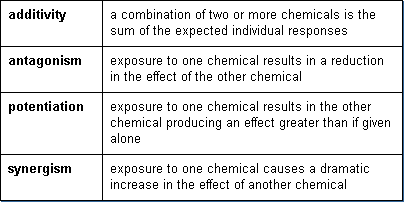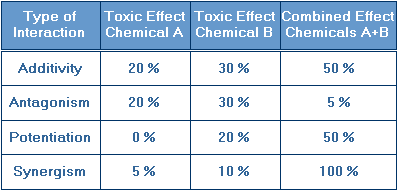|
 |
 |
 |
 |
|
|
|






Types of Interactions

There are four basic types of interactions. Each is based on the expected effects caused by the individual chemicals. The types of interactions are:

This table quantitatively illustrates the percent of the population affected by individual exposure to chemical A and chemical B as well as exposure to the combination of chemical A and chemical B. It also gives the specific type of interaction:

The interactions described can be categorized by their chemical or biological mechanisms as follows:
 |
 |
 |
|  | chemical reactions between chemicals
|
 |
|  | modifications in absorption, metabolism, or excretion
|
 |
|  | reactions at binding sites and receptors
|
 |
|  | physiological changes
|
 |
Additivity

Additivity is the most common type of drug interaction. Examples of chemical or drug additivity reactions are:
 |
 |
 |
|  | Two central nervous system (CNS) depressants taken at the same time, a tranquilizer and alcohol, often cause depression equal to the sum of that caused by each drug.
|
 |
|  | Organophosphate insecticides interfere with nerve conduction. The toxicity of the combination of two organophosphate insecticides is equal to the sum of the toxicity of each.
|
 |
|  | Chlorinated insecticides and halogenated solvents both produce liver toxicity. The hepatotoxicity of an insecticide formulation containing both is equivalent to the sum of the hepatotoxicity of each.
|
 |
Antagonism

Antagonism is often a desirable effect in toxicology and is the basis for most antidotes. Examples include:

Potentiation

Potentiation occurs when a chemical that does not have a specific toxic effect makes another chemical more toxic. Examples are:
 |
 |
 |
|  | The hepatotoxicity of carbon tetrachloride is greatly enhanced by the presence of isopropanol. Such exposure may occur in the workplace.
|
 |
|  | Normally, warfarin (a widely used anticoagulant in cardiac disease) is bound to plasma albumin so that only 2% of the warfarin is active. Drugs which compete for binding sites on albumin increase the level of free warfarin to 4% causing fatal hemorrhage.
|
 |
Synergism

Synergism can have serious health effects. With synergism, exposure to a chemical may drastically increase the effect of another chemical. Examples are:
 |
 |
 |
|  | Exposure to both cigarette smoke and radon results in a significantly greater risk for lung cancer than the sum of the risks of each.
|
 |
|  | The combination of exposure to asbestos and cigarette smoke results in a significantly greater risk for lung cancer than the sum of the risks of each.
|
 |
|  | The hepatotoxicity of a combination of ethanol and carbon tetrachloride is much greater than the sum of the hepatotoxicity of each.
|
 |
Different types of interactions can occur at different target sites for the same combination of two chemicals. For example, chlorinated insecticides and halogenated solvents (which are often used together in insecticide formulations) can produce liver toxicity with the interaction being additive.
The same combination of chemicals produces a different type of interaction on the central nervous system. Chlorinated insecticides stimulate the central nervous system whereas halogenated solvents cause depression of the nervous system. The effect of simultaneous exposure is an antagonistic interaction.

  
|
|
|
|



